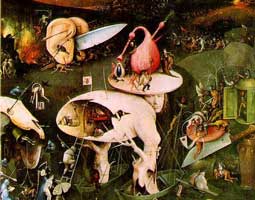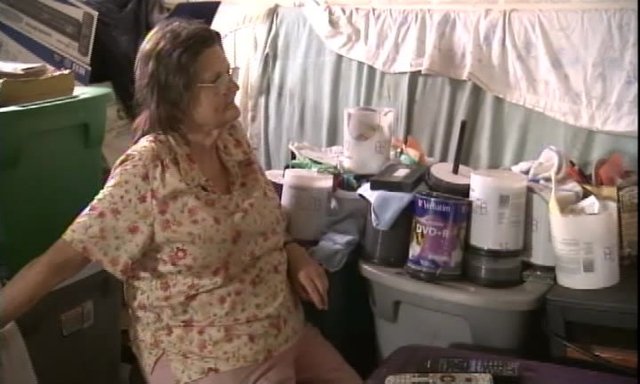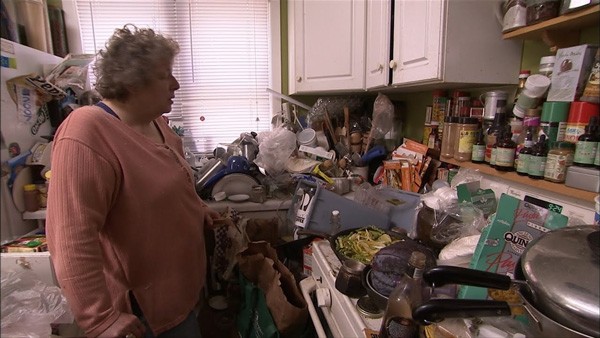On the Television Without Pity online forum, comments about the A & E candid reality show Hoarders have reached page 941. Comic Kathy Lee Griffin was upset that someone tweeted, in her name, her love for Hoarders. She does like the show. But she also supposedly was accused of making fun of the hoarders and thus the mentally ill in one of her comedy routines. What's all this hype about Hoarders/hoaders? Or, rather, why are we obsessed with seeing others who are pathologically obsessed with stuff?
I don't want to blame this hype, nor the mental illness which is now, if I may be cynical, the current mental illness in vogue, on the easy access to material goods, resulting in rampant consumerism, which easily feeds into the disorder. That's too easy an explanation, but some of the hoarders on the show seem to spend much of their time watching and ordering from QVC or hanging about thrift stores, garage sales, or Dollar General. One woman on the show showed her unopened boxes of items bought from practically every home shopping network on the planet. Scary.
Is the explanation for the hoarders' behavior thus more psychological? The presence of “licensed clinical psychologists” to help the hoarders on the show would thus seems to be a given. For example, in many of the show's cases, the hoarding seems to be the byproduct of some kind of unresolved post-traumatic stress disorder. I remember one specifically hat involved unresolved issues about 9/11. In another really sad case, the hoarder, who specialized in food hoarding, had been physically, psychologically, and sexually abused by her now dead ex-husband. She also fed her daughter bizarre dishes like mealworm cookies and chicken hearts pie. Shades of Baby Jane and her infamous fried rat?
Some of the more extreme cases seem to go beyond the frightening colossal disorganization or mounds of clutter (which one might see on shows like Clean House), but to those types of “garbage” houses that occasionally appear as human interest stories on the news, dwellings filled with adult diapers, dead cats, and refrigerators filled with rotting food. In one case in Louisiana, the amount of waste took on apocalyptic proportions. Think decaying heaps of what's left of civilization in a dystopian Mad Max scenario. A follow-up visit showed no improvement. The woman could not explain why she couldn't throw anything out. Literally, anything.
I've given you but a taste of a couple of the more horrific cases. I'll spare you the frankly unwatchable and exploitative animal hoarding cases. But I haven't really answered my most significant question. Why do we watch, other than the usual pull many audiences feel toward reality TV show drama, with its own scripted or semi-scripted climactic and anti-climactic moves, such as “here comes the meltdown”? What is the fascination with Hoarders' often indescribable decay and horror? Is the fascination akin to watching some type of horror movie, except the horror is real, in fact, mundane, which makes it more horrific? The horror of heaps of adult diapers swarming with mouse droppings. The horror of three rooms filled with nothing but the heads of dolls.

Possibly, but I do wonder if this fascination with heaps of stuff has something to do with our fascination with multiplicity in all its forms and functions. I'm not just talking, literally, about our easy access to tons of stuff and our equally easy generation of tons of garbage.
Elias Canetti in Crowds and Power proposes a type of crowd that he claims “modern society” no longer believes in: the invisible crowd. According to Canetti, cultures such as the Greeks, the Norse, and the medieval Christians believed in supernatural invisible crowds such as crowds of ghosts, demons, dead warriors, and saints. The invisible world was densely populated. A multitude of angels could dance on the head of a pin. Once people cease to literally believe in such crowds, scientists discovered other invisible, but natural, crowds through the microscope, such as atoms, bacteria, and all those multitudes of sperm that come out in cum (hence the connection with gay porn). In the case of the hoards, which also resemble Canetti's key images of heaps of the war dead (like the waste heaps of the hoarders) and also heaps of abundant crops, do we once again see something like the more hellish invisible crowds made visible?
And one could even argue that invisible crowds have resurfaced in the flash mobs of the Internet, friends made on social networking sites, all those infinite bytes and kilobytes and megabytes, and their visible manifestation in another type of hoarding, digital hoarding. On Hoarders, Beverly tapes every show she ever watched on television. When VHS became obsolete, she switched to DVD. Her granddaughter is now convincing her to start digitizing all those, as her grandson sarcastically said, Phil Donahue Shows from 1982.

I'm not going to end with the “go clean out your closet” directive, which on boards discussing the show, seems to be the usual reaction to the show. Rather, the show makes me think about how it's remarkably easy to become overwhelmed on all psychosocial fronts, paradoxically, in a society that prides itself on material ease and technical efficiency. Hoarders and hoarding seems to be a most disturbing and visible manifestation of an extreme disorder which can so easily destroy our order like the invisible bacilli of the plague.
It's as if the invisible crowds of Canetti have turned on us.
And now we can see the visible results in those hoards.





 Join our Email List
Join our Email List Like Us on Facebook
Like Us on Facebook Instagram
Instagram Youtube
Youtube Follow Us on Twitter
Follow Us on Twitter Follow us on Pinterest
Follow us on Pinterest